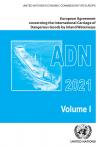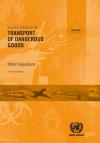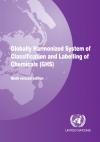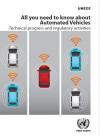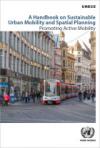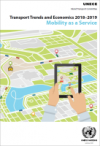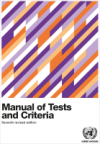Publications
Displaying Results 21 - 40 of 179
- English
From this page it is possible to view and download the text of the annexed regulations to the ADN as applicable from 1 January 2021 (ADN 2021) in PDF format. The electronic version of the publication is made available for information purposes only. To comply with the requirements of ADN, refer to the official UN official publication on paper.
- English
These recommendations have been developed in the light of technical progress, the advent of new substances and materials, the exigencies of modern transport systems and, above all, the requirement to ensure the safety of people, property and the environment. They are addressed to governments and international organisations concerned with the regulation of the transport of dangerous goods. The
- English
The electronic version of GHS Rev.9, available for free for consultation purposes is available here.
Printed versions and electronic editable versions are available for sale at the United Nations Publications section at:
- English
This brochure focuses on the automotive sector developments and governmental responses, as well as provides insights on the activities’ development performed by intergovernmental bodies of UNECE to enable assisted and automated driving as of September 2021. It further includes a short section aimed at providing clarity about various myths.
- English
In April 2020, a UN Task Force was set up to develop recommendations for green and healthy sustainable transport to assist member States in the post COVID-19 recovery. Bringing together over 50 experts from member States, international institutions, academia, public transport operators and industry experts, the Task Force set up under the Transport, Health and Environment Pan-European Programme
- English
The Coronavirus (COVID-19) pandemic has placed our increasingly interconnected world in an unprecedented situation. This crisis has generated human distress and an economic downturn that is impacting global efforts to improve livelihoods and achieve the United Nations Sustainable Development Goals (SDGs).
As the early response to restraining the spread of the COVID-19 pandemic has shown, limited
- Français
L’ADR, fait à Genève le 30 septembre 1957 sous l'égide de la Commission économique des Nations Unies pour l'Europe, est entré en vigueur le 29 janvier 1968.
Cet Accord est destiné à accroître la sécurité du transport international de marchandises dangereuses par route. Ses annexes A et B imposent les conditions dans lesquelles les marchandises dangereuses, lorsqu'elles ne sont pas interdites,
- English
Adopted on 30 September 1957 in Geneva under the auspices of the United Nations Economic Commission for Europe (UNECE), the ADR entered into force on 29 January 1968.
This authoritative Agreement is intended to increase the safety of international transport of dangerous goods by road. Its Annexes A and B contain the technical requirements for road transport, i.e. the conditions under which
- Pусский
Услуги совместной мобильности являются частью экономики совместного пользования, в основе которой лежит идея рационального использования ограниченных ресурсов, создающая для человека возможность позволить себе качественные товары и услуги по разумной цене.
В настоящей работе представлена краткая история возникновения и развития сервисов совместной мобильности, которые способствуют более
- English
Shared mobility services are the part of the shared economy, which is based on the idea of rational use of limited resources, which creates an opportunity for a person to afford highquality goods and services at a reasonable price.This study provides a brief history of the emergence and development of shared mobility services, which contribute to a more efficient use of available resources
- Pусский
В 2002 году государства-члены Европейского региона ЕЭК и ВОЗ разработали Общеевропейскую программу по транспорту, окружающей среде и охране здоровья (ОПТОСОЗ). ОПТОСОЗ обеспечивает межсекторальные и межправительственные политические механизмы, что способствует развитию мобильности и транспортных стратегий, которые учитывают проблемы окружающей среды и здоровья. За все эти годы в рамках ОПТОСОЗ
- English
Member States in the ECE and WHO European Region established the Transport,Health and Environment Pan European Programme (THE PEP) in 2002. By providing an intersectoral and intergovernmental policy framework, THE PEP promotes mobility and transport strategies that integrate environmental and health concerns. Over the years, THE PEP has led to the development of implementation mechanisms to
- English
This study, commissioned by the Steering Committee of the Transport, Health and Environment PanEuropean Programme (THE PEP) through its Partnership on Jobs in Green and Healthy Transport, examines the economy-wide employment implications of an accelerated shift towards greener land
- English
Mobility as a Service (MaaS) is a new mobility concept gaining pace in many cities around the world. Its value proposition concerns integration of mobility services which is realized by providing trip planning and one-stop fare purchase for the user through a single platform.Since MaaS is only emerging, the analysis of real-life demonstrations is still limited and, thus, evidence on the
- English
Regional maps available here
Extreme weather events, some of which are increasing in intensity and frequency, as well as slower onset climate changes (for example, sea level rise) and cumulative effects can result in transportation infrastructure damages, operational disruptions, and
- English
ST/SG/AC.10/11/Rev.7
Sales No. E.20.VIII.1
ISBN 978-92-1-130394-0
eISBN 978-92-1-004503-2
Languages: E, F, (A, C, R, S forthcoming)
How to order this publication?
This publication is also available online for free (download).
The "Manual of Tests and Criteria" contains criteria, test methods and
- English
These recommendations have been developed in the light of technical progress, the advent of new substances and materials, the exigencies of modern transport systems and, above all, the requirement to ensure the safety of people, property and the environment. They are addressed to governments and international organisations concerned with the regulation of the transport of dangerous goods. The
- English
The GHS addresses classification of chemicals by types of hazard and proposes harmonized hazard communication elements, including labels and safety data sheets. It aims at ensuring that information on physical hazards and toxicity from chemicals be available in order to enhance the protection of human health and the environment during the handling, transport and use of these chemicals.
The GHS
- English
The European Agreement concerning the International Carriage of Dangerous Goods by Inland Waterways (ADN) done at Geneva on 26 May 2000 under the auspices of the United Nations Economic Commission for Europe (UNECE) and the Central Commission for Navigation on the Rhine (CCNR) has been in force since February 2008. The Agreement currently has eighteen Contracting Parties. The Regulations
- English
Adopted on 30 September 1957 in Geneva under the auspices of the United Nations Economic Commission for Europe (UNECE), the ADR entered into force on 29 January 1968. This authoritative Agreement is intended to increase the safety of international transport of dangerous goods by road. Its Annexes A and B contain the technical requirements for road transport, i.e. the conditions under


